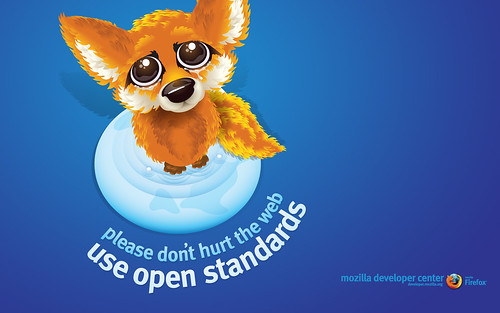Open Source Hackers: Brian Behlendorf’s speech at the Digital Freedom expo
Brian Behlendorf, Apache founder and now CTO at Collabnet, on Thursday at the Digital Freedom Expo gave a speech entitled “Ten things you may not know about open source“.
 Open Standard campaign by 4_eveR_Young
Open Standard campaign by 4_eveR_Young
Some excerpts out of his list:
2. Apache kept the Web flat and free
Apache was launched in 1995, at the time Netscape was the dominant Web browser and there was a fear that if the same company could own the browser market and the server market they would have too much control and could charge companies a tax of sorts for web hosting. Apache’s launch was done with a dual purpose. There was the pragmatic aspect of combining efforts for better development and there was the idealistic aspect of keeping HTTP (Hypertext transfer protocol) as an open standard.
That is really interesting. Enforcing an Open Standards through an open source reference implementation. Someonelse is also suggesting the need for a reference implementation to augment – if not, perhaps, replace – the formal specification of the standard.
4. Open Source helped free the human genome
Before the mapping of the human genome had been completed, a commercial consortium, Celera, was sequencing the genome with the intention of patenting it. This preposterous idea of patenting a discovery rather than an invention began to get many geneticists concerned. In about 2002 a doctoral student, Jim Kent, wrote 10 000 lines of Perl code to make a program that could perform the number crunching of raw data that was necessary in sequencing the genome. This program [Human Genome Project] was then run over 100 Linux servers and the entire genome was successfully sequenced a few months before Celera finished.
While more related to Open Knowledge this story is really interesting, in 2002 Tim O’Reilly described Kent’s work as “the most significant work of open source development in the past year”.
5. Microsoft loves open source
As odd as it sounds, Behlendorf explained that Microsoft has benefitted from open source development and also included software, which although not labeled “open source”, had the source code openly provided. The first use of TCP/IP in Windows was a port of Berkley’s code. He sited the work that Microsoft was doing with open source programs such as MySQL, SugarCRM and JBoss. Codeshare, Channel 9 and other websites were also cited as positive signs that the proprietary giant is openeing further, as Behlendorf put it, “dragged kicking and screaming into the future”.
So I am alone thinking things like that. Ten days ago I happened to see a meeting of developers belonging to a Microsoft’s community and I was quite impressed.
6. Altruism is not the only reason why people contribute to open source software
Many contributors use the software professionally and find that doing things such as fixing bugs and adding features is much easier when collaborating within a group. According to a survey done in 2006, the existing base of FLOSS represents 131 000 real person years of developmental effort. The costs of sharing code are low while the benefits are high.
Many thanks Brian, I am really tired to listen to professors talking about gifts and fun, I am happy that people hacking for real can tell them the truth.
9. Open source can still change the world
Behlendorf strongly believes in the power of open source to make the world a better place, citing many examples. Within government, he believes that open source software can help immensely in counting election votes in a trustworthy way and also with transparency of government’s actions and policy. For countries such as China where there is restricted acces on the internet, open source has already been successful on helping people within these countries get greater access by overcoming the censorship exerted on them. Third world development can benefite greatly through initiatives such as the One Laptop Per Child project which runs on entirely open source software for the dual purpose of making it cheaper to produce and so that it can be modified to suite each country’s specific needs. Fighting digital rights management was another example given.

Reply